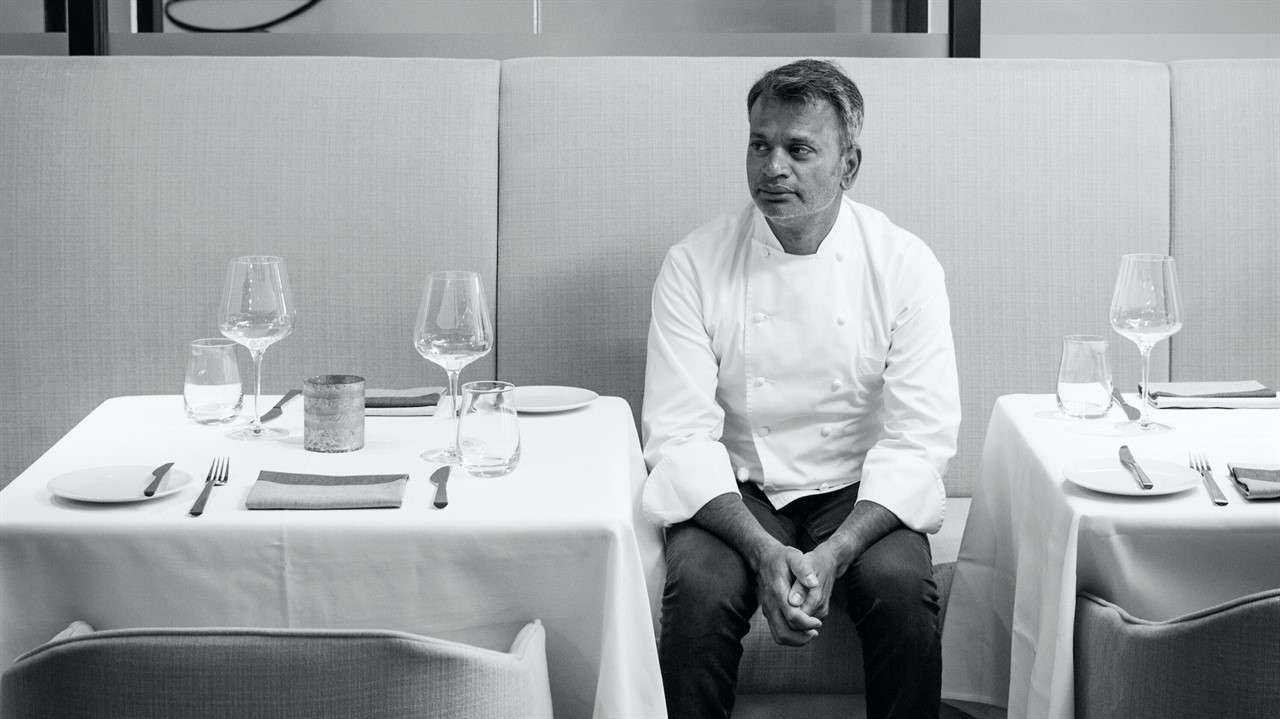Sometimes, it’s not so much our own experiences but those of the people closest to us that inform our opinions of certain films. I was moved enough by Barry Avrich’s “Born Hungry” (2024) on its own merits, but as I watched the story of Sash Simpson, the former homeless street child from Chennai turned internationally renowned Toronto chef, I also realized I was also watching the story of some of my closest friends and family as well. Despite the documentary’s undeniable flaws, I could not help but be moved by it. How other viewers respond, however, may be similarly dependent on how well they themselves identify with the life story unfolding onscreen.
The documentary begins on the eve of the grand opening of Sash Simpson’s eponymous restaurant on Toronto’s Yonge Street. Most of his life has been spent in Canada, where from the age of seven onwards he grew up as one of thirty-two children, all but four of them adopted, in the Toronto household of Sandra and Lloyd Simpson. While he may have attained the pinnacle of success in his profession and joined the culinary elite, memories of those first seven years still weigh down on him. He probably was born in Chennai, he thinks, because that’s where most of those earliest memories are from.
Sash had spoken Tamil in those early years but has completely lost his grasp of the language. He remembers his father and mother best, has fainter memories of two other siblings, and probably ran away around the age of seven, although he may have been abandoned or even simply just gotten lost and wandered away. He doesn’t even remember his birth name. Now, with his greatest professional endeavor set to commence and married with two sons of his own, he’s determined to go back to India, retrace his steps, hopefully find his birth parents and maybe learn more about himself.
Upon his arrival in India, he’s overwhelmed by the size of the country, and old feelings and memories start to rise to the surface. He remembers being hot, cold, being hungry. Always hungry. In his opening narration, he described his early years in Inda as scarring and old wounds start to reopen upon his return, yet this visit is necessary if they are to ever heal. He visits the tobacco factory where his father worked and where female laborers still roll beedis by hand. We learn that his father was deaf and couldn’t speak, and an old employee says he remembers someone meeting this description but that was so long ago. He visits a now-abandoned movie theater that provided him intermittent work and shelter; he recalls sleeping on the floor and the pungent stench of urine, as patrons, wouldn’t get up to go the bathroom lest they miss the movie.

The turning point in his life came when a trio of social workers found him sitting on a bus stop bench and brought him to an orphanage in Coimbatore. He would eventually be adopted by Sandra Simpson, the orphanage’s founder, and her husband Lloyd. Sandra was interviewed for the documentary shortly before her death, and while laryngeal cancer may have stolen her voice, it did not damage her heart. When asked why she adopted Sash, she responds in the faintest whisper, “Because he was a pain in the ass.”
She’s only being honest; as Sash admits, he constantly followed her around the orphanage tugging at her dress, going “Mommy, Mommy! Canada, Canada!” He quickly assimilated into his new home, as evidenced by the images of him growing up: his first family picture shows him in a Fonzie T-shirt and Donny Osmond haircut, followed by a teenage pic of him with Michael Jackson Jerri curls, and as a young adult in the mid-Nineties he has frosted tips in the style of Green Day’s Billie Joe Armstrong.
The story of the Simpson family is the most fascinating in the film, worthy of a documentary all its own. It was very much the idealized image of Toronto in a microcosm, a traditional Anglo couple welcoming children from all around the world, from every race and culture, to join their home where they were all treated as equals. Inevitably, it wasn’t all happiness and sunshine, as two of Sash’s sisters (one of Sandra and Lloyd’s biological children and one another adoptee) relate how they frequently dealt with prejudice from their mostly white neighbors, with no less than nine complaints being made to City Hall highlighting their “concerns” about the Simpson household.
Sash himself went through his own unique hardships while growing up. He was a vexing concern for his teachers, an at best mediocre student despite a strong work ethic that seemed unusual for his age. At home, he enjoyed helping out his mother at dinner time, setting up the table, and cleaning up afterward. It was only natural his first job as a teenager would be as a dishwasher at a chain restaurant, working his way up to fry cook and then after numerous initial rejections, become an apprentice to acclaimed Toronto chef Mark McEwen.
He quickly moved up the culinary ranks to become executive chef of McEwen’s restaurant North 44, up until its closure in 2018. This then opened the door for Simpson to open his own place, serving an eclectic, high-end fusion mix of European and Asian cuisine. While most of his Canadian family is by his side for its opening (Lloyd Simpson died in 2017), he still wants to let his family in India, if they’re still alive, know he turned out OK.
Ironically, the trip to India, which should be the main focus of the documentary and is the source of most of our curiosity, winds up having much of its interest diluted by unnecessary side trips. A visit to a Chennai market, for instance, is important in jogging Simpson’s memory of how such establishments were essential to his survival but then gets sidetracked by his host preparing bheja fry (curried goat brains) for him and the two just engaging in small talk.
A subsequent meeting with celebrity chef Shipra Khanna goes on for far too long, reminiscent of those times Andrew Zimmern would drop in on Anthony Bourdain on one of their shows. It’s much more compelling when Simpson is shown all by himself, appropriately evoking what those sad early years were like when he was all alone yet surrounded by crowds, or when he revisits the old orphanage (still in operation today) and is overwhelmed with emotion.

One of my closest friends was orphaned by the Greek Civil War and eventually adopted by a family in Wyoming. Today he’s a radio astronomer at one of the world’s leading observatories. It was impossible for me to watch the shots of the Chennai slums or the orphanage in Coimbatore without thinking of all the potential greatness squandered worldwide, not just chefs and scientists, but artists, writers, and entrepreneurs, who if not changing the world could potentially enrich it in so many different ways.
I thought of not just material poverty but the absence of emotional support and security, and how it is depriving both them and us alike. Those hard early years may have instilled in Sash Simpson the powerful work ethic that helped him succeed later in life, but it took the love of a family to encourage him to set a goal and follow through on it.
There is also someone even closer to me who was born in Honduras and was also adopted by a Canadian family. She’s now a teacher with children of her own, and whenever she’s asked about visiting her home country or finding her real family, she simply tells them that she’s already living in her home country and that the people who raised her and love her are her real family. In contrast, while Simpson dearly loves his adoptive family and is proud to be Canadian, his heart remains with both his biological family and nation of birth; he needs to reconnect with both before he can consider himself a whole person.
This difference in both identity and attitude is easily attributed to the ages at which they were adopted. One came to Canada at just eighteen months, while the other was forced to wait nearly eight years, and consequently still has vivid memories of his own life before arriving home. As with language acquisition, personal identity depends as much on the life stages during which it develops as much as the life experiences that mold it.
The movie ends with Sash Simpson returning home to the welcoming arms of his wife and sons while Blue Rodeo’s lovely ballad “Lost Together” plays over the end credits. It’s a moving conclusion, but not quite a satisfying one. At just seventy-two minutes, “Born Hungry” cannot help but feel somewhat cursory; we wind up feeling much the same way that Sash Simpson does by the end, that a few questions have been answered but that most of them, including the most pressing, remain unresolved. Some vital ingredients needed to be added, and some of the side dishes were eliminated or at least made more suitable for this serving. It may be appropriate to title a movie “Born Hungry” and leave your audience starved for information, but it also feels a little unfair to do so as well.



![Olive Kitteridge [2014] Review – An uncensored account of repressed emotions](https://79468c92.delivery.rocketcdn.me/wp-content/uploads/2020/10/Olive-Kitteridge-1-highonfilms-768x432.jpg)
![Fiebre Austral (Austral Fever) [2019]: ‘Venice’ Review- An Ode to The Inexplicable Feelings](https://79468c92.delivery.rocketcdn.me/wp-content/uploads/2019/09/fiebre-austral-768x512.jpg)



![Manmarziyaan [2018] Review: Crazy, Stupid Love Indeed](https://79468c92.delivery.rocketcdn.me/wp-content/uploads/2018/10/Manmarziyan_HIGH_ON_FILMS1-768x384.jpg)